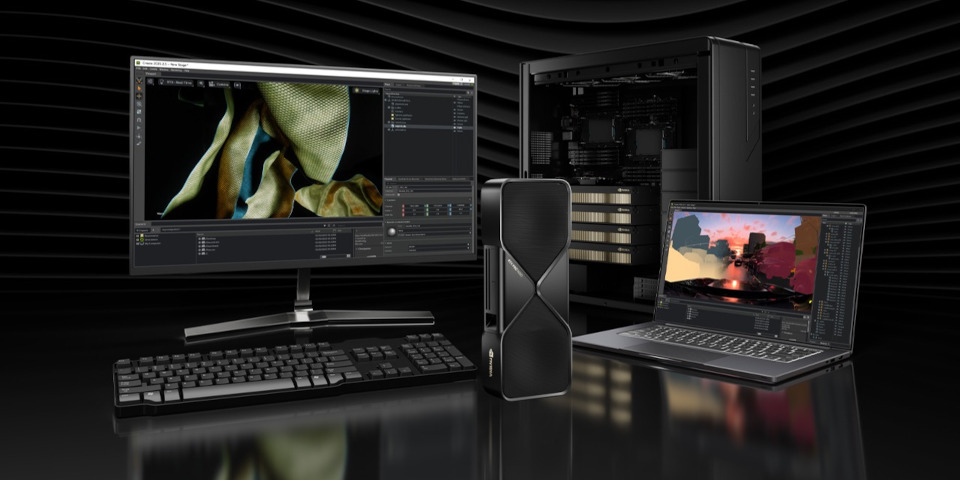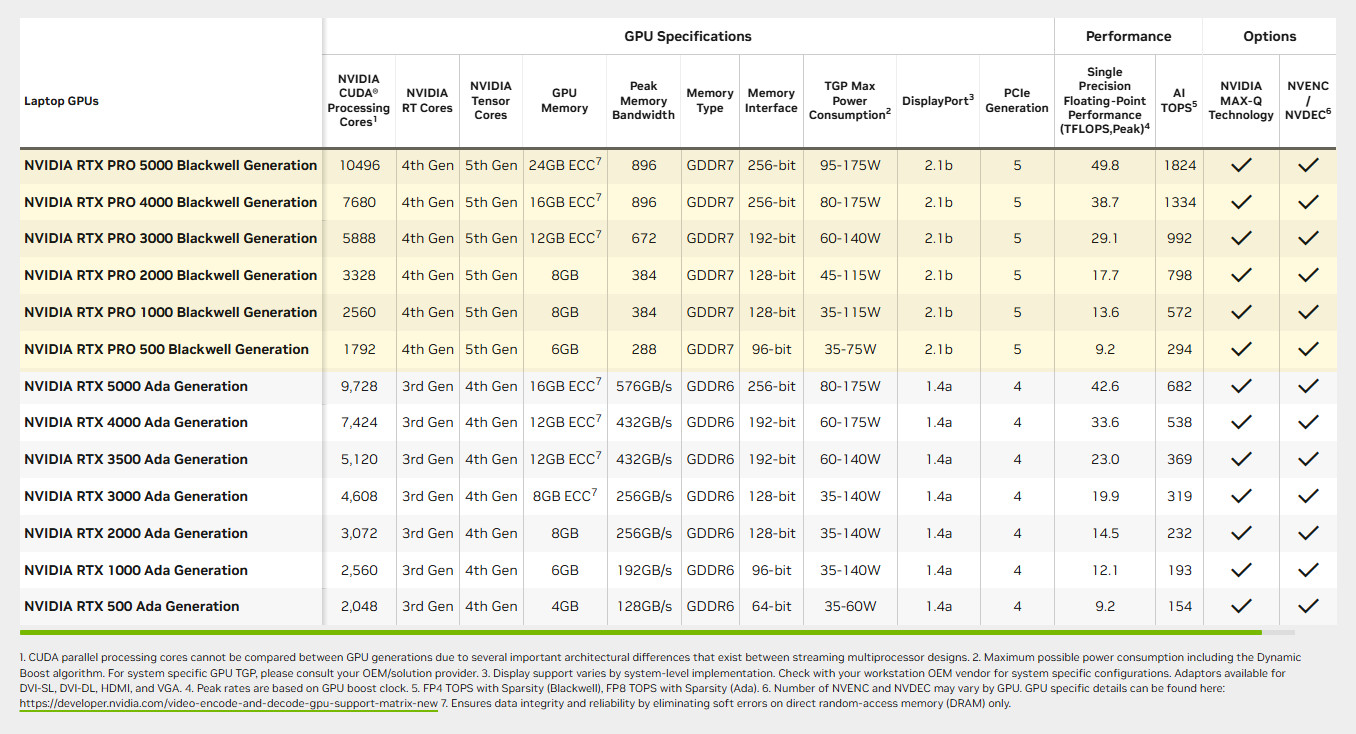NVIDIA unveils Blackwell RTX PRO GPUs with up to 96GB VRAM

NVIDIA has unveiled the RTX PRO Blackwell series, its new range of professional workstation, laptop and data center GPUs based on its current Blackwell GPU architecture.
The first two desktop GPUs, the 96GB RTX PRO 6000 Workstation Edition and RTX PRO 6000 Blackwell Max-Q Workstation Edition, will be available through distribution partners next month.
NVIDIA pitches the RTX PRO 6000 Blackwell Workstation Edition – the larger, more power-hungry version of the card – as “the most powerful desktop GPU ever created”.
The other desktop cards – the RTX PRO 5000, RTX PRO 4500 and RTX PRO 4000 Blackwell GPUs – will be available later in the year, along with the laptop and data center GPUs.
NVIDIA describes the RTX PRO Blackwell series, which is being marketed at agentic AI, simulation, 3D design and VFX, as a “revolutionary generation” of GPUs with “breakthrough accelerated computing, AI inference, ray tracing and neural rendering technologies”.
Below, we’ve rounded up their key specs for DCC work, and what we know about their likely performance in CG software.
The first professional GPUs based on NVIDIA’s new Blackwell architecture
The new cards are the first professional GPUs based on NVIDIA’s Blackwell architecture, following the rollout of their consumer counterparts, the GeForce RTX 50 Series, earlier this year.
All feature the latest iterations of NVIDIA’s key hardware core types: CUDA cores for general GPU compute, Tensor cores for AI operations, and RT cores for hardware ray tracing.
NVIDIA claims that their fifth-gen Tensor cores and fourth-gen RT cores offer “up to 3x” and “up to 2x” the performance of their counterparts in its previous GPU Ada Lovelace architecture.
Their Streaming Multiprocessors, into which the CUDA cores are grouped, have “up to 1.5x faster throughput” than their predecessors, and feature new Neural Shaders that integrate small neural networks into programmable shaders.
The new GPUs use GDDR7 memory and PCIe 5.0 buses, increasing data transfer bandwidth over the Ada Generation cards, and support the current DisplayPort 2.1b display standard.
The RTX PRO 6000 and 5000 cards also support NVIDIA’s Multi-Instance GPU (MIG) technology for partitioning a single GPU into smaller instances.
| NVIDIA Blackwell workstation GPUs and their previous-generation counterparts | |||||||||
|---|---|---|---|---|---|---|---|---|---|
| RTX PRO 6000 Blackwell W/E |
RTX PRO 6000 Blackwell MaxQ W/E |
RTX 6000 | RTX PRO 5000 Blackwell |
RTX 5000 | RTX PRO 4500 Blackwell |
RTX 4500 | RTX PRO 4000 Blackwell |
RTX 4000 | |
| Architecture | Blackwell | Blackwell | Ada Lovelace | Blackwell | Ada Lovelace | Blackwell | Ada Lovelace | Blackwell | Ada Lovelace |
| CUDA cores | 24,064 | 24,064 | 18,176 | 14,080 | 12,800 | 10,496 | 7,680 | 8,960 | 6,144 |
| Tensor cores | (752) | (752) | 568 | TBC | 400 | TBC | 240 | TBC | 192 |
| RT cores | (188) | (188) | 142 | TBC | 100 | TBC | 60 | TBC | 48 |
| Compute performance FP32 (Tflops) |
125 TFlops | 110 TFlops | 91.1 Tflops | TBC | 65.3 Tflops | TBC | 39.6 Tflops | TBC | 26.7 Tflops |
| GPU memory | 96GB GDDR7 |
96GB GDDR7 |
48GB GDDR6 |
48GB GDDR7 |
32GB GDDR6 |
32GB GDDR7 |
24GB GDDR6 |
24GB GDDR7 |
20GB GDDR6 |
| Memory bandwidth | 1,792 GB/s | 1,792 GB/s | 960 GB/s | 1,344 GB/s | 576 GB/s | 896 GB/s | 432 GB/s | TBC | 360 GB/s |
| Graphics bus | PCIe 5.0 x16 | PCIe 5.0 x16 | PCIe 4.0 x16 | PCIe 5.0 x16 | PCIe 4.0 x16 | PCIe 5.0 x16 | PCIe 4.0 x16 | PCIe 5.0 x16 | PCIe 4.0 x16 |
| TDP | 600W | 300W | 300 W | 300W | 250 W | 200W | 210 W | 140W | 130 W |
| Display connectors | 4 x DP 2.1 | 4 x DP 2.1 | 4 x DP 1.4 | 4 x DP 2.1 | 4 x DP 1.4 | 4 x DP 2.1 | 4 x DP 1.4 | 4 x DP 2.1 | 4 x DP 1.4 |
| Size (H x L) | 5.4” x 12.0” Dual slot |
4.4” x 10.5” Dual slot |
4.4” x 10.5” Dual slot |
4.4” x 10.5” Dual slot |
4.4” x 10.5” Dual slot |
4.4” x 10.5” Dual slot |
4.4” x 10.5” Dual slot | 4.4” x 9.5” Single slot | 4.4” x 9.5” Single slot |
| Launch date | 2025 (April) |
2025 (April) |
2022 | 2025 (Summer) |
2023 | 2025 (Summer) |
2023 | 2025 (Summer) |
2023 |
| Launch MSRP | TBC | TBC | $6,799 | TBC | $4,000 | TBC | $2,250 | TBC | $1,250 |
Figures in brackets are taken from third-party websites. W/E refers to the Workstation Edition.
Key specifications for CG work
NVIDIA has only released full specs for the top-of-the-range RTX PRO 6000 Blackwell cards so far, but they are a clear step up from the previous-gen RTX 6000 Ada Generation.
Hardware core counts and compute performance are significantly higher, while GPU memory doubles to 96GB, and memory bandwidth almost doubles.
Power consumption is unchanged – at least for the RTX PRO 6000 Blackwell Max-Q Workstation Edition, which features the same standard cooling design as its predecessor.
That figure doubles to 600W in the RTX PRO 6000 Blackwell Workstation Edition, which uses a double flow-through design, although the increase in compute performance is much smaller.
The specs for the lower-end cards, which also use standard cooling designs, still contain a number of ‘TBCs’, although we would expect them to follow a similar pattern.
What we don’t yet know is how the Blackwell cards will stack up in terms of price-performance, since NVIDIA hasn’t announced recommended pricing.
NVIDIA’s spec chart for the RTX PRO Blackwell laptop GPUs. Click the image to view it full-size.
Also available as data center and laptop GPUs
NVIDIA has also announced its RTX PRO Blackwell series laptop and data center GPUs.
We don’t usually cover either on CG Channel, but you can see NVIDIA’s summary chart for the laptop GPUs above: as well as counterparts for the desktop RTX PRO 5000 and 4000 Blackwell, there are four lower-end cards, the RTX PRO 3000, 2000, 1000 and 500 Blackwell.
Specs for the RTX PRO 6000 Blackwell Server Edition can be found on NVIDIA’s website.
How will the RTX PRO Blackwell GPUs perform with CG software?
The new RTX PRO Blackwell series cards mark a change of branding from the current RTX Ada Generation GPUs, with the new ‘PRO’ tag clearly targeting them at professional users.
What constitutes a professional user is perhaps less clear, since NVIDIA now acknowledges in its marketing for its Blackwell consumer cards, the GeForce RTX 50 Series, that they are used by both “gamers and creators”, with many CG artists using them for rendering.
Rather than video production or VFX, the use cases cited in NVIDIA’s release announcement for the RTX PRO Blackwell cards are computational AI, health care, and design visualization.
As a result, it’s hard to assess how the new GPUs’ specs will translate into real-world performance in CG applications.
Of the examples given, the closest to DCC work is Cyclops, architecture firm Foster + Partners’ GPU ray tracing product for view analysis, which is described as running at “5x the speed” on the new RTX PRO 6000 Blackwell Max-Q Workstation Edition as on the NVIDIA RTX A6000 – its counterpart from two GPU generations ago, which is now over four years old.
Electric vehicle manufacturer Rivian is also quoted as saying that the RTX PRO 6000 Blackwell Workstation Edition delivers “the most stunning visuals we have ever experienced in VR” in Autodesk’s VRED visualization software, but no actual performance figures are given.
Prices and release dates
The RTX PRO 6000 Blackwell Workstation Edition and Max-Q Workstation Edition will be available via PNY and TD SYNNEX in April 2025, and via workstation manufacturers in May 2025.
The RTX PRO 5000, 4500 and 4000 Blackwell desktop GPUs will be available “in the summer”.
RTX PRO Blackwell laptop GPUs will be available via Dell, HP, Lenovo and Razer “later this year”.
NVIDIA hasn’t announced recommended prices for the new GPUs yet.
Read NVIDIA’s announcement of the RTX PRO Blackwell server, desktop and laptop GPUs
Find specifications for the RTX PRO Blackwell desktop GPUs on NVIDIA’s website
Have your say on this story by following CG Channel on Facebook, Instagram and X (formerly Twitter). As well as being able to comment on stories, followers of our social media accounts can see videos we don’t post on the site itself, including making-ofs for the latest VFX movies, animations, games cinematics and motion graphics projects.

